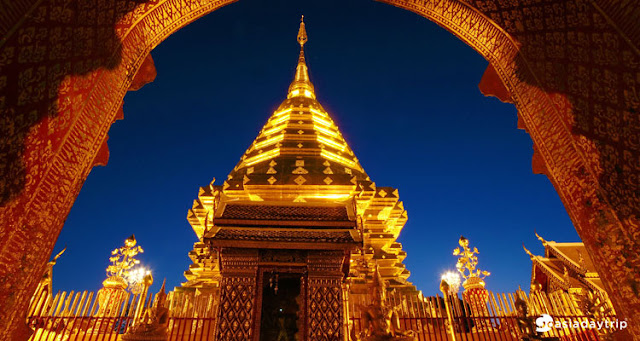The quintessential image of Chiang Mai (Thailand) with its large gold-plated chedi, visible from the city on a clear day, Wat Phrathat Doi Suthep (วัดพระธาตุดอยสุเทพ, Huai Kaeo Rd, 30 baht, [176]) is 18 km from town, sitting at a 1,073 m elevation on the slopes of Doi (Mount) Suthep. Built in 1383 during the Lanna Thai period, legend has it that the temples site was selected by an elephant sent to roam the mountain side, where upon reaching a suitable spot, it trumpeted, circled three times, knelt down and promptly died, which was interpreted as a sign indicating an auspicious site. The temple offers grand views over the city, but no reward is without effort as you must ascend the 300-plus steps of the Naga-lined stairs. The climb may be a strain in the high altitude's thin air for the less fit, so you may opt to take the cable car for 20 baht. For the Visaka Bucha holiday in June or July each year, it is traditional for people to walk from the zoo to the temple and vast numbers make the pilgrimage to the top, which takes around 4-5 hours.

In the vicinity there are several other attractions you may want to consider visiting. The Bhuping Royal Palace Gardens are 4 km further along the road from Wat Prathat, with a reasonably easy walk along the meter-wide road shoulder. Or you can get a shared songthaew from Wat Prathat for 30 baht, but you may have to wait until it fills up. Further along the road is a hill tribe village, and although tourist-oriented, is really worth the trip. There are many shops for local handicrafts, etc. These are the people from the far north of the country, many originally from Myanmar. There are two areas in the village that require entrance fee: 10 baht to enter a flower garden (where women can take pictures using traditional clothes) and a hill tribe opium museum (the museum is in a very poor condition); and 10 baht to enter the hill tribe waterfall (man-made).
Getting there is a source of much consternation to many travellers. Clearly marked songthaews leave from Pratu Chang Phuak. Prices are fixed at 50 baht up and 50 baht down; but the drivers wait until they have sufficient (up to 8) passengers before they depart, potentially making for a lengthy wait. Most guidebooks advise taking a songthaew from Mani Nopharat Rd, resulting in the drivers milking the tourist cash-cow and raising their price from a reasonable 50 baht to a ludicrous 500 baht.
Another option is to take a songthaew from your hotel to Chiang Mai Zoo for 20 baht (if you are close to the city walls), where there will be several songthaews waiting on Huai Kaeo Rd to get a full load of passengers for a trip up the mountain. They seem to congregate around the Chiang Mai Zoo, so if you just say "zoo" to the driver he will know what you're talking about. From the zoo prices range from 40 baht for a one-way trip to Wat Prathat to 180 baht for a full round-trip tour, including the temple, Bhuping Palace Gardens, and the the hill tribe village, with an hour at each location, but you may have to wait until there are sufficient people who want the same tour or be prepared to pay more. You can also get between many of these by buying point-to-point tickets at the time you want them, or walking some segment. Any songthaew up the mountain road may be a trial for those prone to motion-sickness, so take appropriate precautions.

There are several little annoying charges to pay for foreigners. To enter the Doi Suthep itself is free for Thais, and 30 baht for foreigners. Tour operators will ask 700 baht for a tour. You can easily walk up the stairs to the temple but many visitors are encouraged to take the cable car. The cable car ride is short about 5 mins and inside a metal sheet tunnel - therefore no view at all.
The journey from town can be made by motorcycle or a bicycle with appropriate gearing. The final 12 km from the zoo onwards is entirely uphill and will take 60-90 minutes if cycling. Road condition is good but the winding and steep road require some driving and riding experiences.
Comments
Post a Comment